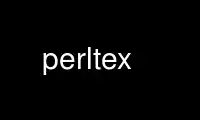
This is the command perltex that can be run in the OnWorks free hosting provider using one of our multiple free online workstations such as Ubuntu Online, Fedora Online, Windows online emulator or MAC OS online emulator
PROGRAM:
NAME
perltex - enable LaTeX macros to be defined in terms of Perl code
SYNOPSIS
perltex [--help] [--latex=program] [--[no]safe] [--permit=feature] [--makesty] [latex
options]
DESCRIPTION
LaTeX -- through the underlying TeX typesetting system -- produces beautifully typeset
documents but has a macro language that is difficult to program. In particular, support
for complex string manipulation is largely lacking. Perl is a popular general-purpose
programming language whose forte is string manipulation. However, it has no typesetting
capabilities whatsoever.
Clearly, Perl's programmability could complement LaTeX's typesetting strengths. perltex
is the tool that enables a symbiosis between the two systems. All a user needs to do is
compile a LaTeX document using perltex instead of latex. (perltex is actually a wrapper
for latex, so no latex functionality is lost.) If the document includes a
"\usepackage{perltex}" in its preamble, then "\perlnewcommand" and "\perlrenewcommand"
macros will be made available. These behave just like LaTeX's "\newcommand" and
"\renewcommand" except that the macro body contains Perl code instead of LaTeX code.
OPTIONS
perltex accepts the following command-line options:
--help
Display basic usage information.
--latex=program
Specify a program to use instead of latex. For example, "--latex=pdflatex" would
typeset the given document using pdflatex instead of ordinary latex.
--[no]safe
Enable or disable sandboxing. With the default of --safe, perltex executes the code
from a "\perlnewcommand" or "\perlrenewcommand" macro within a protected environment
that prohibits ``unsafe'' operations such as accessing files or executing external
programs. Specifying --nosafe gives the LaTeX document carte blanche to execute any
arbitrary Perl code, including that which can harm the user's files. See Safe for
more information.
--permit=feature
Permit particular Perl operations to be performed. The --permit option, which can be
specified more than once on the command line, enables finer-grained control over the
perltex sandbox. See Opcode for more information.
--makesty
Generate a LaTeX style file called noperltex.sty. Replacing the document's
"\usepackage{perltex}" line with "\usepackage{noperltex}" produces the same output but
does not require PerlTeX, making the document suitable for distribution to people who
do not have PerlTeX installed. The disadvantage is that noperltex.sty is specific to
the document that produced it. Any changes to the document's PerlTeX macro
definitions or macro invocations necessitates rerunning perltex with the --makesty
option.
These options are then followed by whatever options are normally passed to latex (or
whatever program was specified with "--latex"), including, for instance, the name of the
.tex file to compile.
EXAMPLES
In its simplest form, perltex is run just like latex:
perltex myfile.tex
To use pdflatex instead of regular latex, use the --latex option:
perltex --latex=pdflatex myfile.tex
If LaTeX gives a ``"trapped by operation mask"'' error and you trust the .tex file you're
trying to compile not to execute malicious Perl code (e.g., because you wrote it
yourself), you can disable perltex's safety mechansisms with --nosafe:
perltex --nosafe myfile.tex
The following command gives documents only perltex's default permissions (":browse") plus
the ability to open files and invoke the "time" command:
perltex --permit=:browse --permit=:filesys_open
--permit=time myfile.tex
ENVIRONMENT
perltex honors the following environment variables:
PERLTEX
Specify the filename of the LaTeX compiler. The LaTeX compiler defaults to
``"latex"''. The "PERLTEX" environment variable overrides this default, and the
--latex command-line option (see "OPTIONS") overrides that.
Use perltex online using onworks.net services
